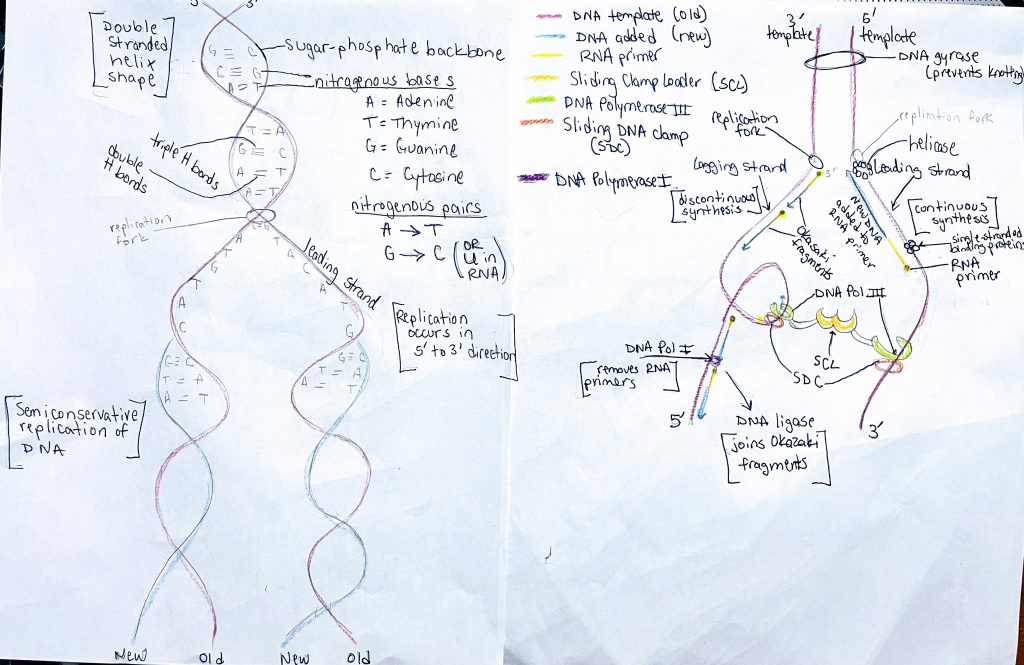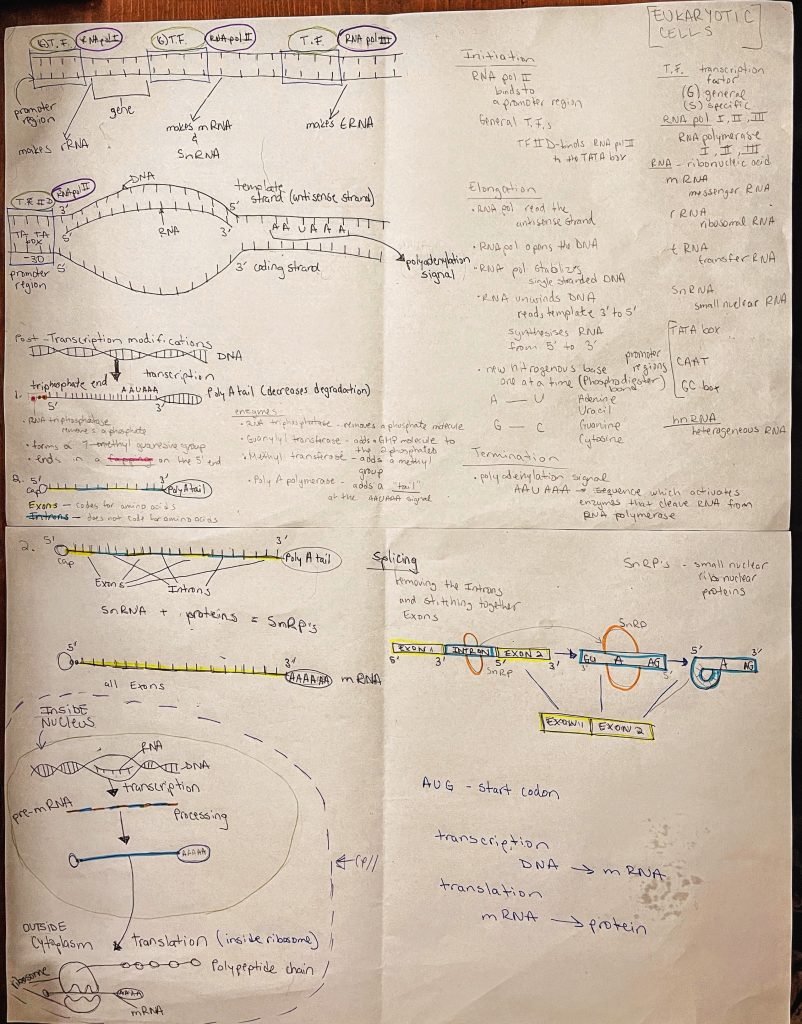Reading Assignment 1: DNA replication

Reading Assignment 2: RNA transcription/translation

Writing Assignment 1:
My name is Likhy Flores; pronounced as Lee-Key. My family and I are from Nicaragua.
I was 9 years old when my family emigrated to the United States, that was back in 1990. The next chapters of my life go something like this: attend elementary school (4th and 5th grade) while learning how speak English, move on to middle school, survive Hurricane Andrew, and then begin my high school years. I truly began my love for science during my high school years. I graduated high school top 20 of my class and went on to university. Sadly, the next chapter of my life is marked by some bad decisions. To make it short, the second year of university I became a single mother. Choosing to drop out of school to provide for my daughter was a tough decision. However, I embraced motherhood wholeheartedly and made the best of life. Fast-forward to 2014 when our family decided to move to Virginia, and we chose to settle in the Hampton Roads area. I had a decent job, my daughter was in middle school, and overall, the move to Virginia was the best decision of our lives. I am not certain when it happened, but the yearning to go back to school to finish university surfaced. After looking at school options and programs in the area, I enrolled at Tidewater Community College (TCC) during the Spring of 2017.
The plan was simple- attend and graduate from TCC in 2 years with an Associates of Science, Civil Engineering; then transfer to Old Dominion University (ODU) to graduate with my bachelor’s degree in 2 years, while keeping a full-time job. Once at ODU I would focus on Environmental Engineering.
The plan did not go as planned.
First, I graduated from TCC in 3 years’ time, because working full time takes a lot of your time. Second, my degree was Biology, because Civil (Environmental) Engineering was not what I thought it was. This was the Spring of 2020, when the world was flipped upside-down. Additionally, the same year, my daughter graduated from high school and was college bound. I had to make another tough decision- to afford my daughter’s tuition, I decided not to continue as originally planned, and put on hold my chapter of attending ODU…enter COVID.
Without realizing it, 4 years went by in a blur. In 2020 we lost family and friends to COVID and learned to practice Social Distancing. In 2021 our family succumbed to COVID, spent almost 3 months at home sick. This took a toll on our physical and mental health. 2022 was personally tough for me because of work. Without going into detail, I am a contractor for the State and as such rated as essential personnel. Not much to say about 2023, most likely because it looked a lot like 2022. In 2024, my daughter graduated from TCC and was accepted to the University of Virginia. Watching my daughter walk the stage for her graduation stirred the yearning for completion of my own collegiate journey.
I started the latest chapter of my life in the Fall of 2024, as a transfer student at ODU pursuing my degree in Biology. My original plan for an Environmental Engineering degree was no longer a thing. Reason why? Because I like science more than math! After 2 semesters at ODU, I am currently experiencing an existential crisis. So far, I have completed Ecology, Evolution, and Cell Biology. I am currently enrolled in Genetics. So far, all these courses have highlighted topics that spark that “ooh” moment. Simply put- I like Biology, but I don’t yet know how this chapter will end.
Writing Assignment 2:
What is a primary article? The simplest definition for primary article is that it is an original article. This primary article contains original data, not based on someone else’s work. There are no citations in a primary article. Before publishing, the primary article goes through the peer-review process. For example, in my research on whether dogs can speak or not speak I find evidence of the following- dogs do speak but choose not to speak. I then go on to type up my research findings and draft a primary article. This primary article I would then submit to a scientific journal.
We then have a review article, which is not to be confused with peer-reviewed article. A review article takes a subject of choice, looks at several original articles, and provides a summary of the findings. To continue with the dogs can speak scenario—Other scientists working with dogs have also, independently, found evidence that they can speak. Those scientists also publish their primary articles. Then, an ODU graduate student embarks on a research journey where she reads 5 different publications, all about dogs being able to speak. This student proceeds to type up a review article, which contains a summary of all the primary publications.
Before an article is published, it must first go through a review process. After typing my draft primary article on speaking dogs, and it is submitted to a scientific journal, the journal’s editor will be the first to review the article. If it meets the journal’s criteria, the draft article is sent to be peer-reviewed. The peer review process is intense and critical. The journal’s editor will send the article to subject matter experts. These experts will dissect my draft article, fact check data, be extremely critical to check the validity of the proposed findings. If an article passes the peer-review stage, it goes back to the Journal for publication.
Writing Assignment 3:
Writing Assignment #3- Primary Article-Citation and Sections
Ognibene, J. M., Desai, R. I., Kulkarni, P. P. & Ferris, C. F. Chronic exposure to inhaled vaporized cannabis high in Δ9-THC suppresses Adderall-induced brain activity. Frontiers in pharmacology 15, 1413812 (2024). https://doi.org/10.3389/fphar.2024.1413812
The article is a primary article because it contains the following sections:
- Background information
- Introduces the hypothesis for the study
- Introduces Methods
- Discusses Results
- Introduction includes methods, materials, and how the drugs were prepared
- Has a conclusion section
Writing Assignment 4:
Writing Assignment #4 – Summary of a Genetics-Related Article
Popular press article citation:
Davies, M. (2025, June 20). NHS plans to DNA test all babies in England to assess disease risk: BBC News.
Article Summary:
The article was centered around the announcement coming out of England involving the future of newborns. According to the article, all newborns will have their DNA mapped by collecting samples from umbilical cords, which would be collected shortly after birth. The author of the article referred to this plan as a “scheme” by the government as part of a drive towards predicting and preventing illness. The idea is to catch any future diseases now, work on prevention, and avoid costly medical expenses down the road. Think of it as personalized healthcare. DNA sequencing can provide a lot of information about a person, which can then be used to diagnose diseases such as muscular dystrophy.
England’s Department of Health and Social Care explained it will use genomics and AI to provide diagnoses faster than traditional methods. Apparently, this is a 10-year plan, with more information to follow in the weeks to come, which will provide more details.
Additionally, through funding, the English government hopes to build a large database off this research. By adding to an already existing database, they hope to contain over 500,000 genomes by 2030.
This article is heavily centered on Genetics and how it can be used in the medical field to aid the human population. DNA and DNA mapping are at the core of genetic engineering, which is why this article was chosen.
There is much research already existing which corroborates the validity of this idea. According to research, evidence has shown that DNAm patterns in blood-derived DNA are associated with the status of asthma1. With thousands of single-gene disorders, much like asthma, the idea is that these can be mapped for each infant, right after birth, to avoid costly medical issues later in life.
Reference:
- Li, L., et al. Newborn DNA methylation and asthma acquisition across adolescence and early adulthood. Clinical & Experimental Allergy. https://doi-org.proxy.lib.odu.edu/10.1111/cea.14091 (2022).
